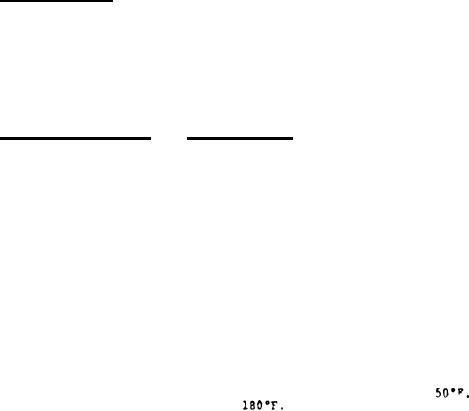
MIL-P-24475 (SHIPS)
4.3.1.1 Hydrostatic pressure test. Each pump casing shall be tested hydrostatically
to pressure one and one-half times the maximum discharge pressure but in no case less
than 50 pounds per square inch gage (p.s.i.g.). The hydrostatic test pressure shall be
maintained for at least 30 minutes or longer as necessary for examination of entire casing.
Acceptance criteria: The pumps shall exhibit no leakage through the casing material,
or joints The leakage rate through the mechanical seal shall not exceed 5 drops per minute.
4.3.1.2 Over-speed test. Continuous shaft and rigid coupled pumps shall be tested
with the driver Units separately driven through flexible couplings and geared units may
be tested by separate pump, gear unit and driver over-speed tests. The dynamic balance
shall be checked by the use of a vibration inculcator of the neon tube type whereby vibrations
of an amplitude of 0.001 inch may be readily observed on a scale.
.
Acceptance criteria: The pump including driver and appurtenances shall exhibit no
abnormal noises or roughness of operation. The maximum acceptable reading (double amplitude)
of the vibration indicator shall not exceed 0.001 inch as measured on the bearing cap or
0.002 inch as measured on the rotating shaft adjacent to the bearings.
4.3.1.3 Mechanical soundness and capacity tests. This shop test shall be conducted,
recorded and reported in accordance with the centrifugal pump Rating Standard and Test Code
of the Hydraulic Institute, to the extent that these standards are applicable and are not
in conflict with the requirements specified herein. The test record for each pump shall
identify the pump by manufacturer's serial number, it shall indicate the diameter of the
pump Impeller being tested in the pump, it shall include a description (by legend and sketch)
of the test stand arrangement including an Identifying list of test Instruments used and the
date when last calibrated, and it shall include the data sheets of all recorded data and
sample calculations of data conversion to specified conditions. Test data used for plotting
the head-capacity curve shall be corrected to the specified operating conditions. The
test shall be performed in three phases, as follows:
(a)
Operate the pump continuously at maximum rated speed and capacity, with the
pumped fluid at ambient temperature (see 6.1) until bearing temperatures
stabllize as manifested by at least three consecutive equal bearing -tempera-
ture indications taken at intervals of not less than 15 minutes. The pump
operation shall be fully monitored throughout this test for proper function-
ing of seals and bearing lubrication,. and for smooth running.
Acceptance criteria. Operation shall be without over-heating and shall be free
of
abnormal vibrations and noises. There shall be no abnormal leakage of water, grease
or oil.
Oil temperature rise in force feed lubricated bearings shall not exceed
in any
bearing
with inlet cooling water to the
oil
and shall not exceed a maximum temperature of
cooler at 85°F.
(b) Operate the pump at the maximum rated speed, from recirculation flow to as
close to free delivery as practicable and with the specified suction con-
ditions prevailing. The unit shall be operated at seven or more test points,
throughout the full operating range to establish accurately the head-capacity
curve at maximum rated speed. The unit shall be operated at each test point
until the test values being measured stabilize.
Acceptance criteria: The pump shall deliver the rated capacity and head. The head-
capacity curve at maximun rated speed shall conform to the specified requirements. The
total head at all capacities on the curve shall not deviate by more than plus 5 percent of
rated heads from the corresponding capacity on the head-capacity curve at maximum, rated
speed established in the performance test specified in 4.3.2.1,
Operate the electric motor-driven unit for a minimum of 1 minute in reverse
(c)
rotation at maximum rated speed.
Acceptance criteria: The unit shall not be damaged by the reverse rotation test.
Conformance to hydraulic and noise requirements shall be demonstrated subsequent to the
reverse rotation test.
4.3.1.4 Noise test. When required (see 6.1), a noise test shall be conducted and
reported in accordance with MIL-STD-740. The noise test stand details, instrumentation.
and testing technique shall be submitted by the supplier for review acceptance by the
procuring agency (Government or shipbuilder) prior to test commencement. Noise tests shall
be performed with the driver furnished with the pump. Airborne noise tests shall be con-
ducted on the lead unit only on each contract or order.
Acceptance criteria:
The unit shall meet the noise level limits specified (see 6.1).
16
For Parts Inquires call Parts Hangar, Inc (727) 493-0744
© Copyright 2015 Integrated Publishing, Inc.
A Service Disabled Veteran Owned Small Business